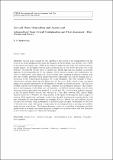Advanced low-noise aircraft configurations and their assessment: past, present, and future
Author(s)
Spakovszky, Z. S
Download13272_2019_371_ReferencePDF.pdf (8.848Mb)
Open Access Policy
Open Access Policy
Creative Commons Attribution-Noncommercial-Share Alike
Terms of use
Metadata
Show full item recordAbstract
Abstract
Aircraft noise remains the key inhibitor of the growth of air transportation, but the focus of the noise mitigation strategies has changed. As the propulsor fan pressure ratio is decreased for improved fuel burn and lessened environmental impact, the propulsion system noise can be reduced near or even below the noise level of the airframe. Jet noise has become less of a concern, and during approach and landing, the acoustic signature is predominantly set by the airframe. Novel aircraft concepts and architectures, enabled by distributed, more integrated, and boundary-layer ingesting propulsion systems, pose new aeroacoustic problems which require innovative approaches and call for teaming and collaboration as the technological challenges cut across disciplines. One past example of such a collaborative research effort was the Silent Aircraft Initiative (SAI), aimed at the conceptual design of an aircraft imperceptible to the human ear outside the airport perimeter. The initiative brought together researchers from academia, industry, and government agencies. This chapter gives a brief summary of the Silent Aircraft Initiative, the SAX-40 aircraft design, and the noise reduction technologies which were pursued. A decade past SAI, novel aircraft architectures such as the D8 double bubble aircraft, the outcome of a joint effort between MIT, Aurora Flight Sciences and Pratt and Whitney, are being pursued in the quest of reducing the climate impact of aviation. With regulations continuing to reduce the allowable aviation noise emission levels, both new challenges and new opportunities are emerging. Electric, hybrid, and turbo-electric aircraft concepts are currently being investigated as potential game changers. Independent of the level of electrification, noise will remain a major issue as air transportation is growing and mobility might become a key driver. The chapter discusses a selection of enabling technologies and their implications on acoustics and noise and gives a perspective on future trends and new directions in aeroacoustics required to address the challenges.
Date issued
2019-03-16Department
Massachusetts Institute of Technology. Gas Turbine LaboratoryPublisher
Springer Vienna